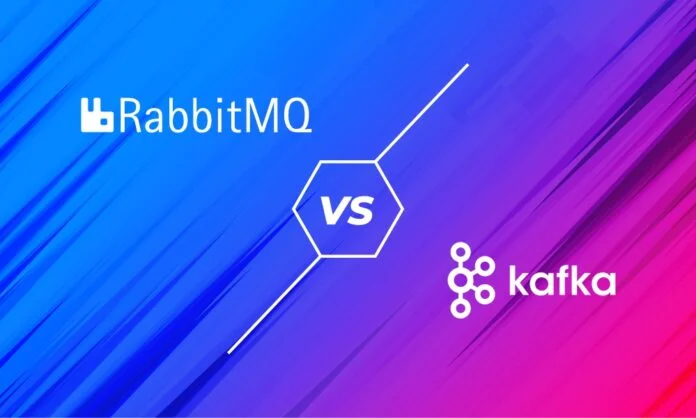Data has become a part of day-to-day lives. We rely on data immensely for varied purposes. Software, mobile devices, services, and more combine to form a web that makes a difference. Say you’re making an online transaction, enabling microservices for effective communication or other, it is essential to manage the data flow between the different elements wisely. To get things done easily, developers generally rely on message brokers to exchange information and communicate with each other.
Amongst the most widely used are Apache Kafka and RabbitMQ that allow message exchange, moreover, differ in architecture, use cases and more. Here’s a blog that explains the key differences between Kafka and RabbitMQ alongside, use cases and when to choose each.
Without any further ado, let’s get started.
What Is Apache Kafka?
Released in 2011, Apache Kafka is an open-source distributed event streaming platform that processes data in real time. It’s mainly built on Java and Scala and uses the publish-subscribe model and buffers messages in a persistent log for durable, replayable delivery. It’s based on a pull-based technique wherein the customers pull messages from offsets.
What Is RabbitMQ?
RabbitMQ is a distributed message broker that, even in challenging situations, offers dependable message delivery and sophisticated routing. Numerous protocols, including AMQP, MQTT, and STOMP, are supported by RabbitMQ, which also offers broad language support. It’s particularly suited for low-latency messaging and systems where strong delivery assurances are needed.
Key Differences: Kafka vs RabbitMQ
Here are the differences you need to know.
1] Architecture
Apache Kafka and RabbitMQ have different structures, that go well with their design goals. Kafka is mainly partitioned, replicated and distributed commit log service tailored for fault tolerance and real-time data streams. It operates on a pull model, wherein consumers pull the messages from partitioned topics maintained across brokers, and it keeps data on disk, allowing messages to be replayed and retained for the long term.
Conversely, RabbitMQ is a message broker that works on push-based architecture utilizing the Advanced Message Queuing Protocol (AMQP). It forwards messages via exchanges to queues and delivers them to consumers, emphasizing flexible routing, low latency, and advanced messaging patterns such as fan-out, topic, and direct exchanges.
2] Performance
Performance is the key to success. Both RabbitMQ and Kafka excel when it comes to offering top performance message transmissions for their particular use. Moreover,
Kafka still goes above and beyond RabbitMQ in message transmission capacity. Now another important point to consider is, Kafka can send billion messages per second with its sequential I/O disk to foster high-throughput message exchange.
On the other hand, RabbitMQ can also send millions of messages in a second, however, it needs multiple brokers to carry out the task. You might get a slower performance if RabbitMQ’s queues are piled up and congested.
3] Security
Security is highly important when it comes to exchanging messages. Here, RabbitMQ and Kafka both allow secure transmission of messages between apps, but with different technologies. RabbitMQ comes with administrator tools to manage user rights and broker security.
4] Data Flow
It’s alternate. The data flow in RabbitMQ is distinct and bounded. The messages are crafted and sent by the one who produces it, while received by the consumers.
Conversely, Apache Kafka uses unbounded data flow wherein the key value pair is streamed to the given topic constantly.
5] Data Usage
When we talk about data usage, RabbitMQ is ideal for transactional data such as placing orders, user requests and more. For Apache Kafka it goes with the operational data such as auditing, system activity, etc.
6] Language Support
RabbitMQ supports some of the popular programming languages, such as Go, Python, PHP, Spring and JavaScript. In terms of language support, Kafka goes well with Node.js, Java, Ruby and Python.
Check out this table for a clear and simpler view:
 Use Cases of RabbitMQ and Kafka
Use Cases of RabbitMQ and Kafka
Kafka is ideal for:
- Real-time distributed streaming.
- Collecting logs from different sources/log aggregation
- Event-driven architecture
- Handle massive volumes of data
RabbitMQ is ideal for:
- Can be easily integrated with legacy applications
- Task scheduling and job processing
- Communication between microservices
- Flexible message routing
Final Words
What works best for you, Kafka or RabbitMQ, will definitely depend on the systems’ architectural needs, operational complexity and more. RabbitMQ is ideal for single broker implementation and is mainly apt for single scenarios. Whereas Kafka stands as an effective distributed streaming platform used for publishing, storage and subscribing to streams of records, allowing real-time data processing and analysis.
Check out our blogs on more relevant tech topics.
Recommended For You:
Power BI vs QlikView: Key Differences Between the Two to Know


 Use Cases of RabbitMQ and Kafka
Use Cases of RabbitMQ and Kafka